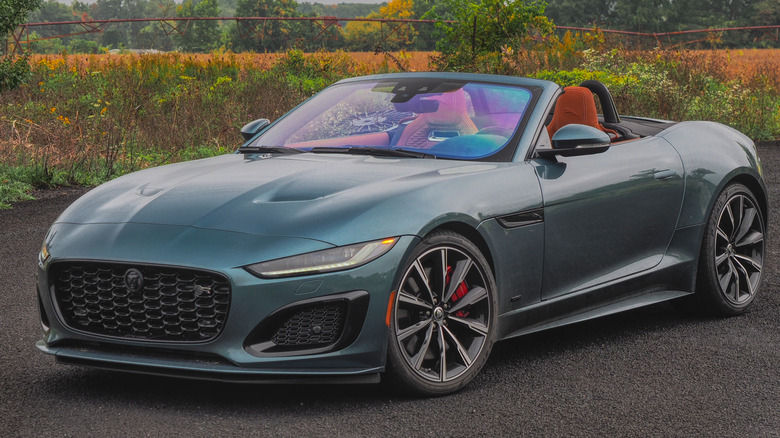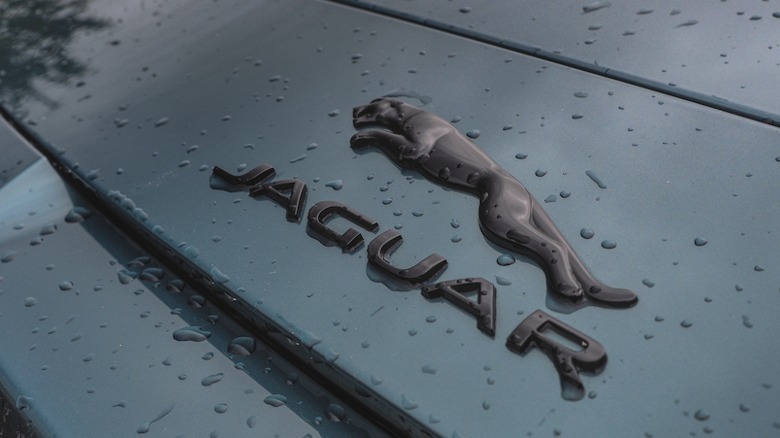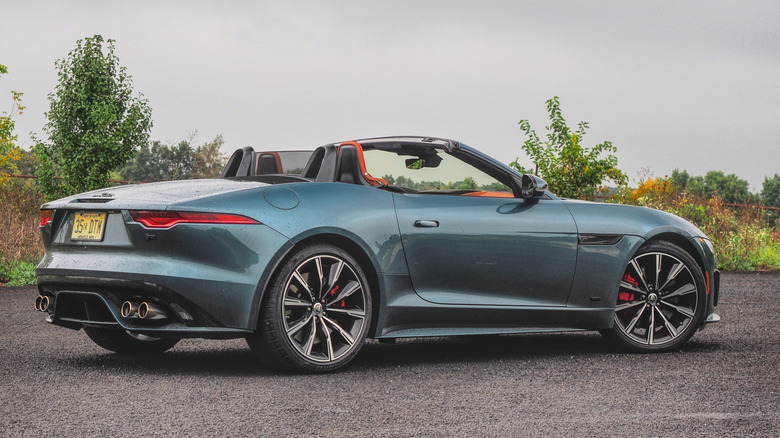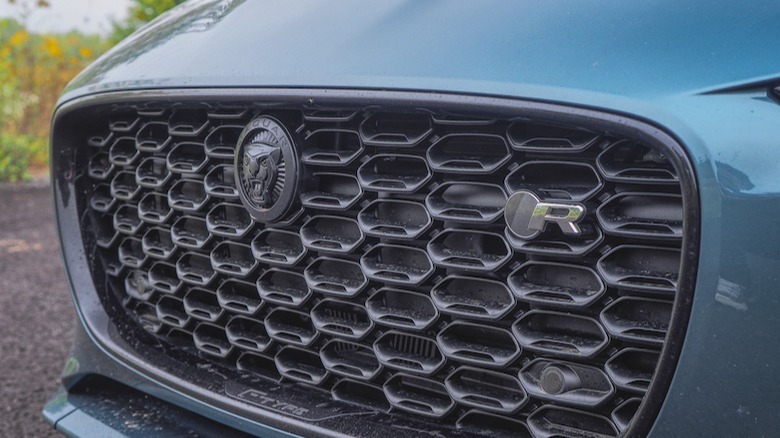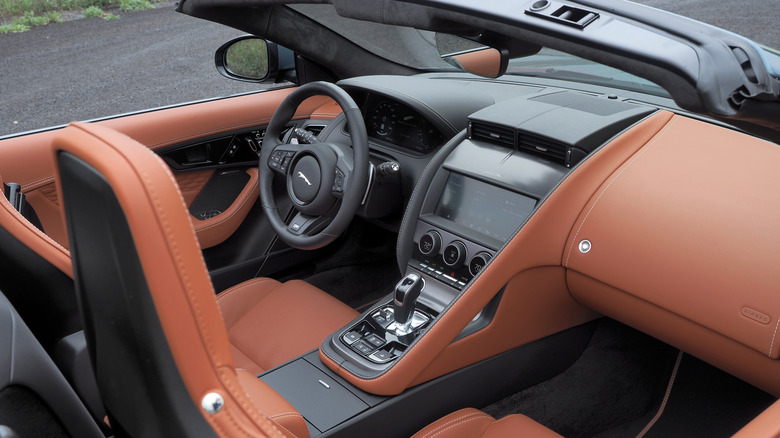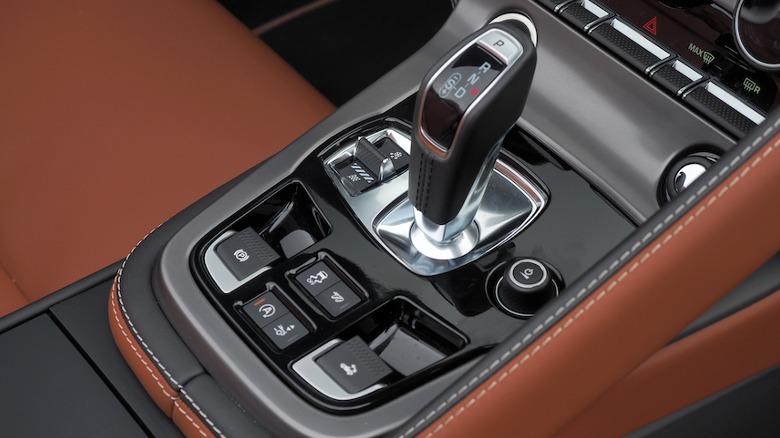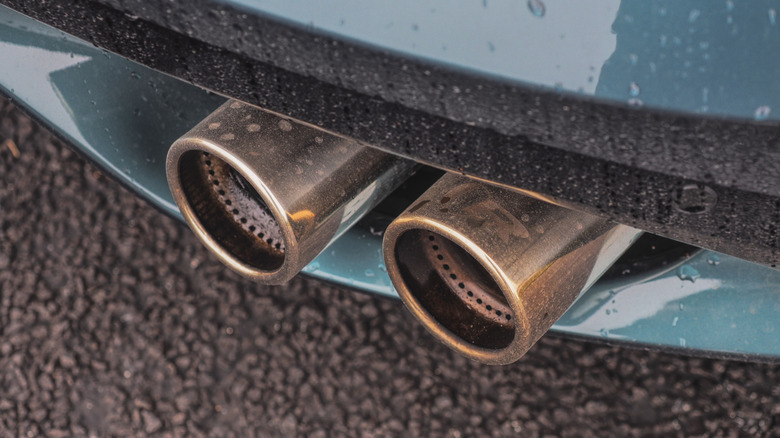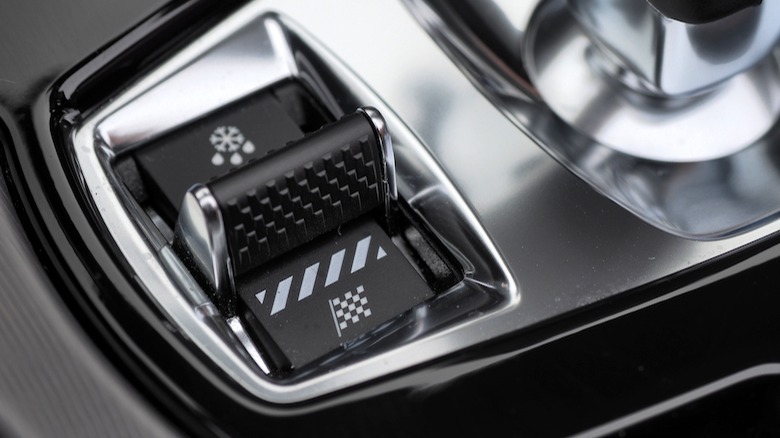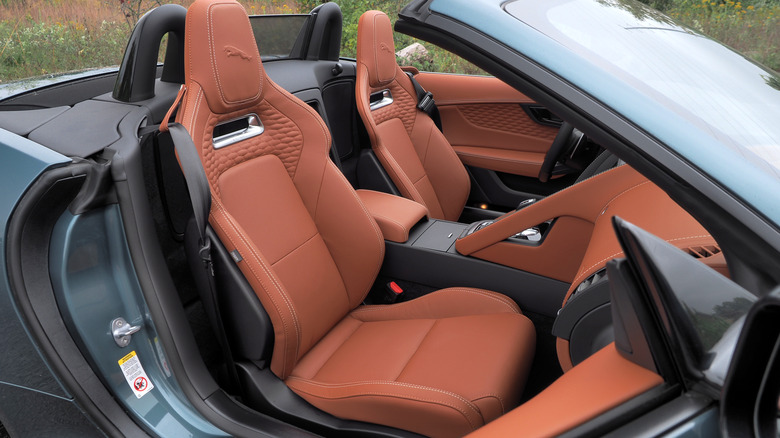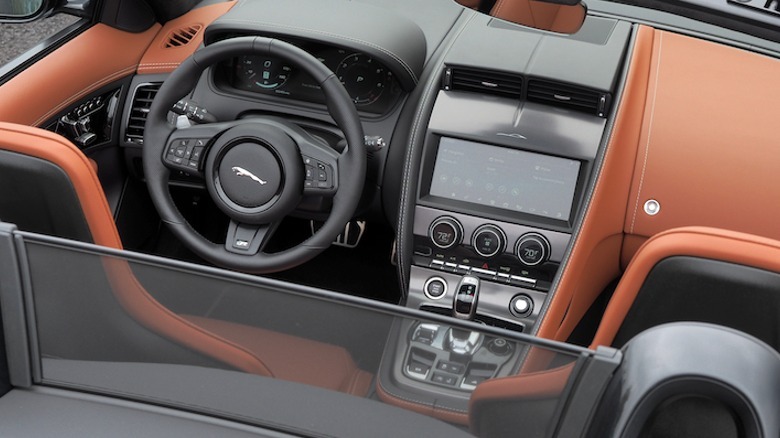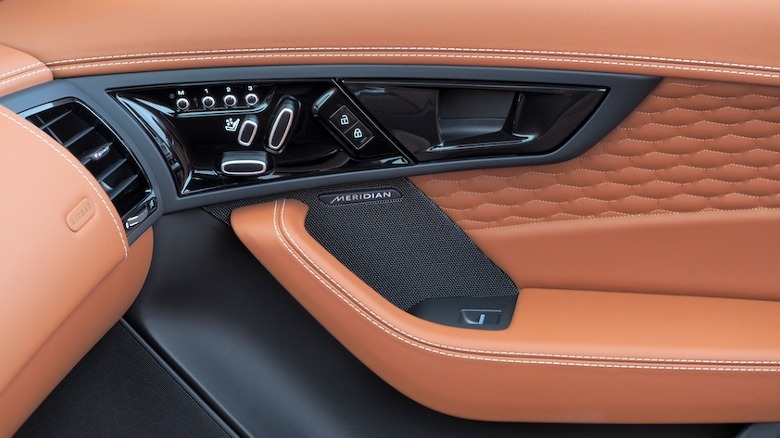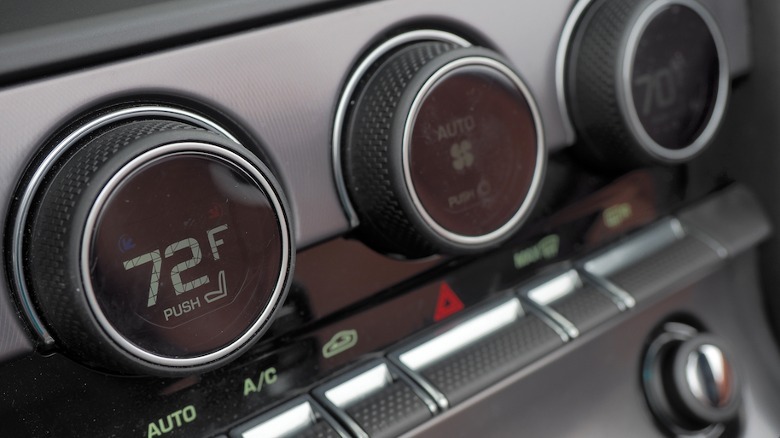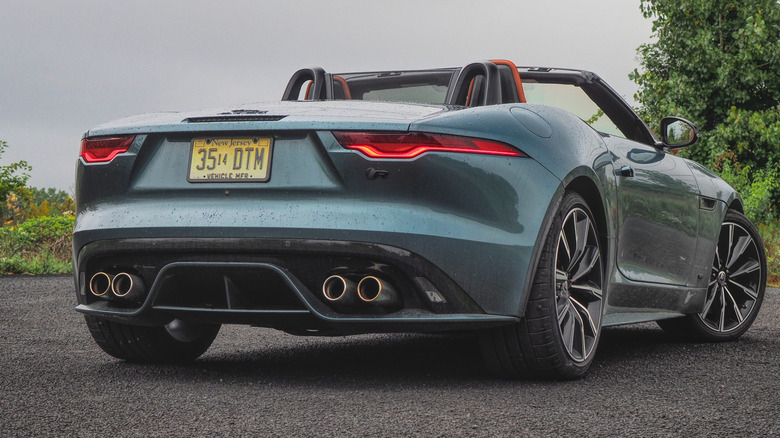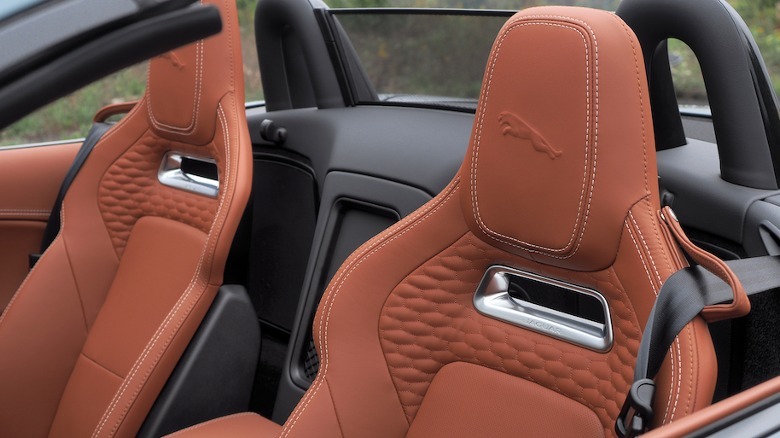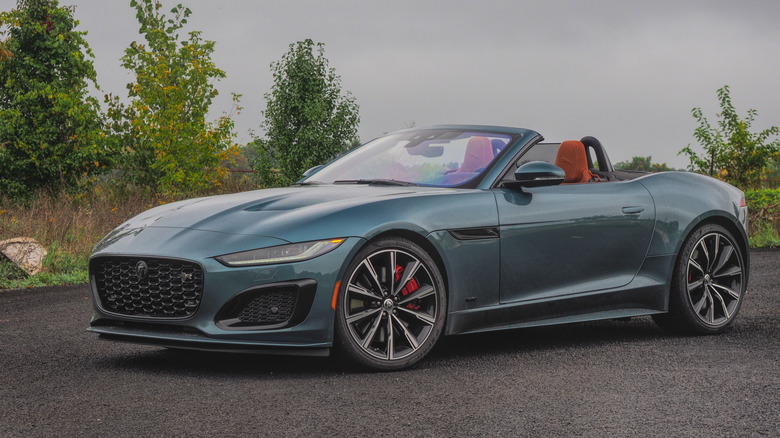2024 Jaguar F-Type Review: What We Lose, And What Comes Next
- Head-turning style even after a decade
- Glorious V8 is loud and proud
- Luxurious cabin cossets nicely
- Redesigned fascia is polarizing
- Not as dynamically polished as rivals
Even those cheerleading the new age of entirely electric vehicles might find themselves disheartened by some of the sacrifices along the way. After all, your head can agree that EVs are a great idea in comparison to burning fossil fuels, but that doesn't stop your heart from having favorites among the old-school — regardless, or even because of, how flawed they are. Witness, by way of fine example, the 2024 Jaguar F-Type.
While the F-Type might not be a natural comparison to Dodge's Charger and Challenger, Jaguar's two-door does have something in common. All three are being put out to pasture, as their respective automakers look to electrification. A big, loud V8 is neither fashionable nor fuel-efficient, and so sacrifices must be made.
Where the Dodge duo are slab-sided, Jaguar's coupe and convertible are sinuously curvaceous. I'm seemingly in the minority about the F-Type's redesign for the 2021 model year — I don't share my colleague's F-Type 75 First Drive opinion that the tautened front grille and slimmer headlamps ruined its looks, here — because it looks pretty good to my eyes. Sinister and aggressive, and even after a decade still capable of grabbing attention.
V8 all the way, baby
Aesthetic squabbles aside, it's hard not to be charmed by Jaguar's 5.0-liter supercharged V8. Though the original F-Type launched with a supercharged V6 as standard and the 2021 F-Type refresh added a four-cylinder turbocharged option, the burly V8 suits the British bruiser nicely. Power figures have fluctuated over time, but as the F-Type R75 bows out it does so with 575 horsepower and 516 lb-ft of torque.
That's sufficient, Jaguar says, for a 0-60 mph time of just 3.5 seconds, regardless of whether you opt for the coupe or the $2k more expensive convertible. The top speed clocks in at an electronically limited 186 mph.
If that's more than you require, the F-Type 75 and R-Dynamic have a 444 horsepower version of the same engine. It'll do the 0-60 dash in 4.4 seconds, and keep going to 177 mph. As well as being cheaper, starting at $77,900 versus the R75's $113,000 opening price, it also offers a rear-wheel drive configuration for sports car purists. The F-Type R75 can only be had with all-wheel drive as standard.
Focus on the big picture
Honestly though, getting as much power from under the hood to the asphalt seems like a darn fine idea. For its part, Jaguar throws in much of the mechanical and electronic trickery that makes AWD cars so engaging these days (even if they also make a case for the F-Type as an unusual but probably pretty fun winter driver).
There's an electronic active differential to nudge power between the rear wheels, and torque vectoring using braking to improve cornering. Unlike the seemingly endless drive modes and configurations that other sports cars offer these days, Jaguar's approach puts the essentials within reach. A simple toggle switch turns Sport mode or Wet/Snow mode on or off, and there's an "S" position for the 8-speed Quickshift transmission.
Adaptive Dynamics relies on electronically-controlled, continuously variable dampers to tighten and soften the ride depending on road conditions, driving style, and other factors. If you really must, you can dig into the Configurable Dynamics system and tweak steering weight, suspension stiffness, transmission shifts, and throttle response.
Sing, my angel of music
You can do all that, but I'm not sure you should. Really, there's one button that deserves attention, and it's for the switchable active exhaust system. Usually, that's deactivated when driving normally — though the F-Type still sounds pretty darn peachy nonetheless — but it's either enabled when you switch to Sport mode or when your baser auditory urges get the better of you. Then, the soundtrack really gets good.
Up to around 3,500 rpm, the F-Type grunts and growls pleasingly. Kick past that — which is, coincidentally or not, when peak torque arrives in the R75 — and all hell breaks loose. Louder, certainly, but also more raucous and borderline unhinged. Jaguar calls it a "distinctive crackle and pop," but that's like describing a machine gun's rat-a-tat as "a little feisty."
Heads turn, eyes widen, and passengers — assuming they're not pre-warned — give you either the evil eye or a come-hither stare, depending on how alluring they find braying excess. Jaguar does have a Quiet Start feature, but this is quiet by comparative degrees. Nobody will ever describe the F-Type as subtle.
Quintessential luxury wrapping questionable tech
Why would you want subtle, though? Certainly, that's never been the F-Type's reason for existence. Jaguar is aiming instead to channel its halcyon days of E-Type and XK into something similarly show-stopping for the 21st century. The result leaned into the idea of lavish performance: a grand tourer with personality.
That focus also helps insulate the Jaguar from some of the places it's now feeling its age. The F-Type's cabin remains a comfortable place to be, albeit a snug one, and these 2024 end-of-an-era examples benefit from having the fancier materials previously on the options list now made standard. That means Windsor leather with monogram stitching on the R75 and 75's Performance seats, door panels, and dashboard, along with an Ebony Suedecloth headliner.
Compared to the touchscreen-centric interfaces of other recent luxury droptops, Jaguar's comes from a time when physical controls were still the status-quo. That means dedicated knobs for the climate control, toggles for key features, and buttons for the roof and other systems.
The infotainment system itself is probably the clunkiest part, even after Jaguar's revamp a few years back. It's not dire, but it's just not as easy to navigate nor swift as compared to what's in the automaker's current models, and the screen itself could do with being brighter and more color-saturated to compete with roof-down sunny days.
Inside you there are two cats
Embrace all that, and the F-Type sparkles still. It chomps through longer drives with surefooted grace, smooth and refined; even the R75's Performance seats aren't the chiropractor-summoning buckets that some of Jaguar's rivals assume make as much sense on the road as at the race track. Crank up the Meridian sound system and the whole thing feels positively Riviera-ready.
Find yourself some tighter turns, meanwhile, and the F-Type proves similarly memorable. There's a heft to it when driven aggressively, a sense of muscle beneath the tailored suit that recognizes matching effort being applied by the person at the wheel. The end result isn't as clean and crisp as other sports cars in the class, but it definitely suits the Jaguar's overall personality.
Fuel economy is an unexpected success, given the size of the V8 and its inclination toward speed. Jaguar quotes 16 mpg in the city, 24 mpg on the highway, and 18 mpg combined. No, the F-Type isn't exactly frugal or "green" for that, but it's potentially better than many sports cars if you can show some restraint with your right foot.
2024 Jaguar F-Type Verdict
Goodbyes are difficult, and Jaguar is facing a particularly significant one. Come 2025, the automaker has said, all the new Jaguar models on the roadmap will be EVs. It's not like that will be a single sweep across every category, of course, and so we may be waiting some time to see an F-Type replacement.
Where, then, does a brave new world of electrification take Jaguar and others like it, as the sports car is reimagined for zero emissions? There's a part of me which is glad the automaker didn't just squeeze an EV drivetrain into this familiar body, sad as it is to see the F-Type bow out. Electric performance cars deserve an era of their own, all the better to explore their strengths — like instant torque, effortless hush, and reinvented packaging — without trying to force them into the silhouette of an earlier generation.
All the same, just as the F-Type aimed to distill E-Type allure without directly replicating the older car, there's plenty a future Jaguar sports EV could learn from its gasoline predecessor. A duality of driving moods, for instance, along with a sense of melodrama, and remembering that speed-loving owners usually like their creature comforts, too. The age of the F-Type may be at an end, but there are far worse blueprints for what could come next.
